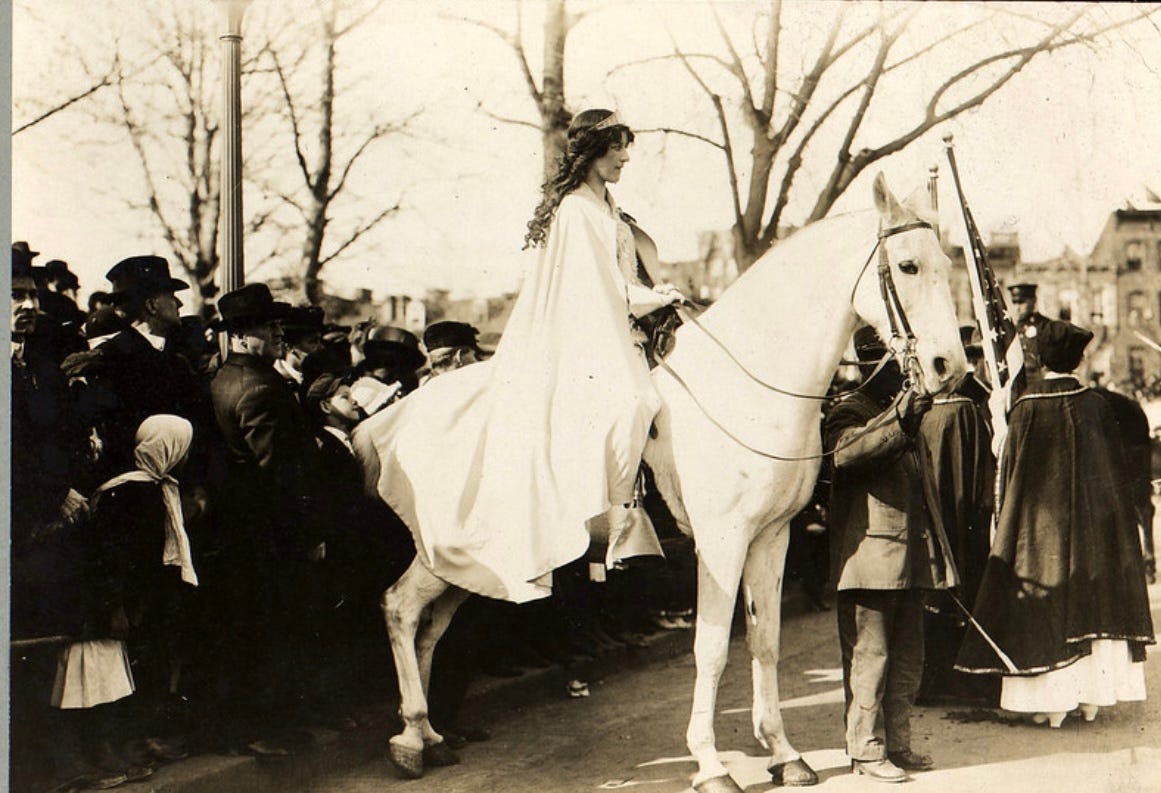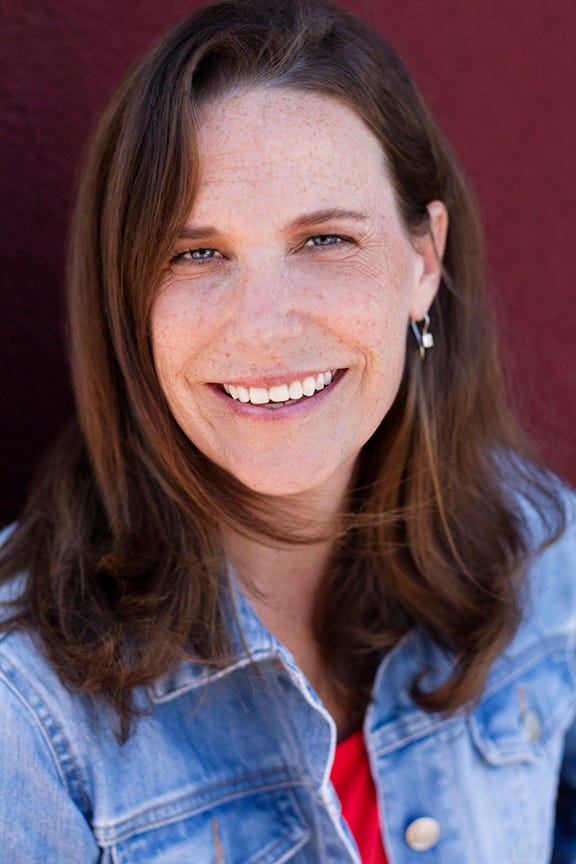She died fighting for women's right to vote
Little remembered today, Inez Milholland was the face and a principal voice of the women's suffrage movement in the early 20th century.
Inez Millholland leading women’s suffrage parade in Washington, D.C., 1913. Photo credit: Library of Congress, Grantham Bain Collection
For most of her life, Jeanine Michna-Bales knew little about the long struggle for American women to gain the right to vote. She was unaware of the decades of fighting against the stubborn opposition of popular opinion, members of Congress and a succession of presidents. She knew nothing about the street protests in which women demanding enfranchisement were verbally abused, spit on, beaten and jailed.
She never heard of Inez Milholland.
"All I learned was that there were x, y, z amendments and the 19th Amendment [women's suffrage] was one of them," Michna-Bales told me recently by phone. "That was it. I had no idea all of the things women had to go through to fight for what we have today."
In 2010, Michna-Bales, a 51-year-old professional photographer who lives in Dallas, was doing research for her book Through Darkness to Light: Photographs Along the Underground Railroad, for which she photographed a route from Mississippi to Ontario, Canada taken by runaway slaves. She learned about the abolitionists who were also activists in the early movement for womens' right to vote.
After Through Darkness to Light came out in 2017, Michna-Bales plunged deeper into researching the American suffrage movement. She came across a photograph of a banner that someone carried at a 1910 suffragist protest. It read Forward Out of Darkness/Leave Behind The Night/Forward Out of Error/Forward Into Light. It was eerily similar to the title of her Underground Railroad book.
"That clearly caught my attention," she said. "I was like that's just weird. That's an odd coincidence or synchronicity. So I wondered who carried the banner. It was Inez Milholland."
She was curious. Who was Inez Milholland? The more she learned, the more intrigued she became.
Inez Millholland. Photo credit: U.S. State Department
Inez Milholland was born in Brooklyn, then a separate city, in 1886. Her father, a wealthy businessman, and mother were unusually progressive for their times. Among their unconventional views, they believed that all people of all genders, race and ethnic background were entitled to equal rights.
Milholland attended to Vassar College, one of the top women’s colleges in the nation. She soon ran afoul of Vassar’s male president for organizing pro-suffrage protests. After graduating, she enrolled at New York University Law School. She had been rejected by Harvard and Columbia, which didn’t accept women.
In 1913, she went to work as a lawyer at a time when it was unusual, even shocking to many people, that a woman would work outside of the home except as a domestic. As a young activist attorney in New York, Milholland opposed the U.S. entering the world war in Europe. She fought against capital punishment and racial discrimination and spoke out for better treatment of prison inmates. She also was drawn to the growing American suffragist movement as it was heating up in the early years of the new century. It would become her passion.
When Milholland met Alice Paul, one of the nation's leading suffragists and head of the National American Woman Suffrage Association, Paul immediately recognized that Milholland's intelligence, oratory, fiery charisma, and attractiveness were public relations gold. She was right. Milholland became the face of the suffrage movement. The press fawned over her which, as Paul had suspected, drew more attention to their cause.
"(It) was difficult for the press and public to absorb the radical message beneath her pleasing surface," wrote Linda Lumsden in her biography Inez/The Life and Times of Inez Milholland. "Yet, minus her beauty, sadly, it is doubtful anyone would have paid attention to her in the first place. She was more than just a pretty face; her image was not simply that of beauty but of a bold, brave woman who used her brains to right wrongs and champion the unfortunate."
In 1913, Milholland, then 26, led a large suffragist demonstration in Washington, D.C. She was a striking figure wearing a flamboyant crown and dressed in white and astride a horse named Gray Dawn. When the march began, a mob of drunken male onlookers became enraged and started attacking the protestors, tearing at their clothes, pummeling them, shrieking obscenities and throwing lighted matches at their garments. The D.C. police stood by and did nothing.
At one point, angry men surrounded Milholland and her horse, trying to pull her down. She repelled them and rode on through the crowd, shouting, "You men ought to be ashamed of yourselves standing there idly and permitting this sort of thing to happen. If you had a particle of backbone you would come here and help us continue our parade."
The melee was eventually suppressed by federal troops. Milholland and her cause drew national press coverage.
"Newspapers nationwide splashed across their front pages a wire story that described her charge through the mob; many ran photographs of her astride Gray Dawn," Lumsden wrote. "Milholland was the 'real heroine of the procession,' claimed the Los Angeles Times. Literally taking the reins into her own hands, Milholland displayed female agency."
Later in 1913, she was traveling by ship to England. Onboard, she met a Dutchman named Eugen Jan Boissevain. They fell in love so quickly that Milholland proposed to Boissevain before they even reached England. They were married soon afterward. That marriage would cost her her American citizenship. At that time, if an American woman wed a foreigner, she automatically lost her U.S. citizenship. The same did not apply to American men.
Three years later, as the 1916 presidential campaign approached, Paul came up with the idea of sending Milholland as a "special flying envoy" for the National Women's Party to the Western states - where women could vote - to campaign against President Woodrow Wilson, a misogynist and ardent foe of women's suffrage, and his fellow Democrats in Congress, where suffrage legislation had been bottled up for years.
It would be Inez Milholland's most ambitious effort on behalf of women's suffrage. It would also be her last.
Jeanine Michna-Bales, author of Standing Together/Inez Millholland’s Final Campaign For Women’s Suffrage
Jeanine Michna-Bales was determined to do a photography book about the women’s suffrage movement. But what kind of book? And with photos of what? She was stumped.
“I was trying to find a way to access the story and make it compelling. Do I go to all these locations and photograph them? Then you don’t really have a (human) connection to the story," she said.
Then she came up with it. She would tell the story of the fight for women's suffrage by recounting and depicting the 1916 trip to the West that Inez Milholland took to rally women in the states to oppose Wilson and his fellow congressional Democrats. Michna-Bales would capture in images the sights Milholland visited and would recreate her travels in scenes of women of different ages and races dressed in period attire as if they were Milholland. The title of the book would be Standing Together.
On October 4, 1916, Milholland, now 30, and her younger sister, Vida, traveled by train from New York to Chicago where they would start the campaign. When she arrived in Chicago, Milholland was suffering from severe headaches and pain in her neck and back. She was depleted and was experiencing strange heart palpitations. Her body was covered with strange bruises. She consulted a doctor. He found her tonsils in bad shape but otherwise thought she was fit enough to travel.
Images from Standing Together
The tour was a grind. She and Vida traveled by train virtually nonstop. Often taking overnight trains and sitting in coach, they went to Wyoming, Montana, Idaho, Washington, Oregon, Utah, Nevada and California.
At the first stop, in Cheyenne, Wyoming, Milholland delivered a fiery speech.
"Women of the West, stand by us now," she exhorted. "Make them feel your indignation. Let them know that women stand by women."
Milholland was constantly on the move, giving as many as three speeches a day, doing interviews and attending parades, luncheons, dinners and receptions. It would have been a grueling pace for anyone but Milholland was not well. Though she hid it in public, she was thoroughly worn down and racked by debilitating headaches and constant neck pain.
"After each meeting she wilted and looked like a ghost," her sister said.
She saw several doctors in a desperate attempt to figure out what was wrong with her and cure it. A physician in Montana diagnosed her with anemia and prescribed arsenic, strychnine and iron to combat it. At first, it helped. Then it didn't. She pressed on just the same.
"I don't see how I am able to keep going," she told a reporter in Montana, "but I just have to."
On October 23rd, she arrived in Los Angeles, exhausted and weak. That night she addressed an overflow crowd at Blanchard Hall in downtown L.A.
"She spoke with her usual fire and conviction," wrote Lumsden. "'President Wilson, how long must this go on?' she asked. By then, her head was swimming. 'Let me repeat - we are not putting our faith in any man or any party but in the women voters of the West.' She raised her arm to make a point in the middle of a particularly impassioned plea. But the effort was too much. Milholland crumpled to the stage like a wilted rose."
As the horrified audience watched quietly, she was led from the stage. Fifteen minutes later she returned. Seated and wobbling, she finished her remarks and took questions before returning to her hotel. The next day. Vida convinced her to enter the hospital. She never got out. She died on November 25th,1916.
“Transitioning,” from Standing Together
"She was so far ahead of her time in the way she thought about gender equality," Michna-Bales told me. "She was not embarrassed or timid about her beliefs. She spoke out and spoke her mind and was attacked for it frequently and she just kept going. I absolutely fell in love with her."
Wilson was narrowly reelected in 1916, but his party lost control of Congress in the 1918 midterms and the new House and Senate passed legislation that gave women the right to vote everywhere. It was ratified by three-fourth of states, and became the 19th Amendment to the Constitution in 1920.
But the 19th Amendment, historic as it was, only addressed voting rights. In 1923, the first Equal Rights Amendment granting full legal rights to women was introduced in Congress. It failed. It would be re-introduced year after year until an ERA was finally passed by Congress in 1972. The amendment reads in part, "Equality of rights under the law shall not be denied or abridged by the United States or by any state on account of sex.
But still it needed ratification by three-fourth of the states within ten years. It came up three states short when the deadline arrived. But the fight wasn't over. In 2020, Virginia became the 38th state to ratify the ERA, giving it the required three-fourth majority. The next year, the House of Representatives passed a resolution removing the deadline for ratification. If the Senate passed it, it would be the law of the land. But Senate Republicans used procedural maneuvers to prevent it from coming to a vote. It remains stalled to this day.
More than a century ago, Inez Milholland said, "Liberty must be fought for. And, women of the nation, this is the time to fight."
She may have been ahead of our time too.









Excellent story!
I love the way you shine a light on people who are unknown heroes.
Remarkable story well written! Wonder if a documentary or film has ever been done on her.